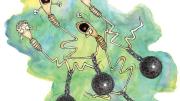Many women fantasize about it: a male birth-control pill. After all, most existing contraceptives place sole responsibility for preventing pregnancy on the female partner. And hormone-based op- tions such as the pill, though effective, also come with potential side effects, including an increased risk for life-threatening blood clots in some women. But recent discoveries about sperm made in the lab of David Clapham, Castañeda professor of cardiovascular research, could now make this fantasy real.
Clapham says he never set out to unlock the mysteries of sperm; his research focuses not on reproduction, but on the ion channels found in heart and nerve cells. These gateways in cell membranes allow charged molecules to flow in and out. “Ion channels are basically the transistors of cells,” Clapham explains. “All cells are batteries, and ion channels are like the switches on those batteries.” He’s particularly interested in calcium channels, which play critical roles in the body by coordinating heart contractions and allowing nerve cells to secrete neurotransmitters.
In 1999, Clapham’s team was combing the then-new database of human genes, looking for any that would yield previously undiscovered ion channels. That’s when they stumbled upon a gene that appeared to create a calcium channel in the testes alone.
“If we were narrow-minded, I guess we would have stopped there and said, ‘Well, that’s not our field,’” Clapham says. “But I always think you learn something when you go new places, so we decided to pursue it.” The fact that this calcium channel appeared to be so specific intrigued him. “Rarely do you find ion channels that [exist] only in one place,” he explains. They discovered that this channel developed only in the tails of mature sperm, and named it CatSper (short for “cation channel of sperm”). To understand how CatSper works, Clapham’s team engineered so-called “knock-out” mice that lacked the CatSper gene. Deleting it had no effect on female mice, but male mice without it “were 100 percent infertile,” Clapham reports.
He then turned to two researchers known for their work on sperm: the late David Garbers of the University of Texas Southwestern Medical Center in Dallas, and Donner Babcock of the University of Washington in Seattle. Subsequent work in their labs revealed that CatSper helps the sperm prepare for the final leg of their journey to the egg.
Once ejaculated, sperm ordinarily swim with “a sort of sinusoidal motion,” Clapham says. “The tail moves back and forth in this symmetric way that’s very beautiful, actually. It’s like a pennant flapping in the breeze.” But as sperm approach the egg, they undergo a process called hyperactivation. The CatSper channel conducts calcium, sending sperm “into a sort of hyperdrive. Their tails make an asymmetric motion that’s best described as like cracking a whip,” Clap ham says. This gives sperm up to 20 times the force of normal swimming, enabling them to penetrate the cumulus, a protective coating of cells around the egg. Without CatSper to spark this extra force, the sperm and egg can’t join.
A new contraceptive based on these findings makes sense, Clapham says. Ion channels are common drug targets because they’re located on the easy-to-access surface of cells. Researchers could develop a molecule to bind to the channel, preventing calcium from entering the sperm tail. A man might take the drug before intercourse, but Clapham adds that it could work in women, too, because fertilization occurs in the female reproductive tract: “If what we’ve seen in mice is true in humans—and we think that’s the case—it would block fertility.”
Yet such a contraceptive may be a long time coming. One pharmaceutical firm expressed interest, but company executives subsequently halted all work on new contraceptives. Clapham says other major pharmaceutical companies have done the same. They have several reasons. To begin with, existing contraceptives work, so there’s little motivation to develop new ones. Furthermore, the enormous expense of drug trials, which can cost hundreds of millions of dollars, means pharmaceutical companies feel pressure to develop wildly popular drugs with large markets to cover their costs, and they’re also leery of potential litigation. “Drug companies want low risk,” Clapham says. “A drug with severe side effects is accepted by society for serious, life-threatening diseases, like cancer. When the alternative is death, one is willing to accept problems.” Contraceptives, on the other hand, are generally used by young, healthy people, so society is less tolerant of side effects. Clapham also notes that anticontraception attitudes now run strong in the United States. “Few public companies,” he says, “want political liability in any form.”
~Erin O’Donnell






